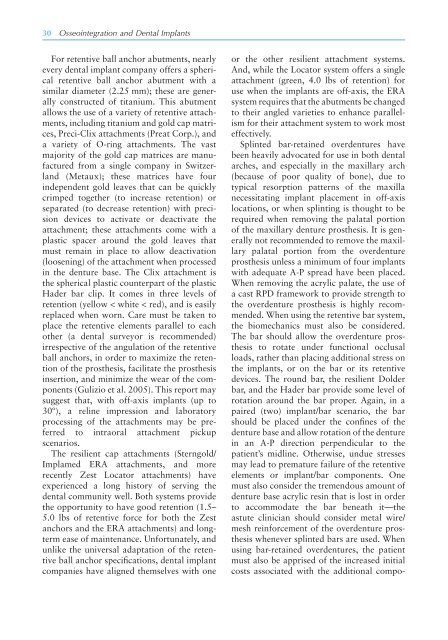Untitled - Link 1 Link 16 Link 2 Link 17 Link 3 Link 18 Link 4 Link 19 ...
Untitled - Link 1 Link 16 Link 2 Link 17 Link 3 Link 18 Link 4 Link 19 ...
Untitled - Link 1 Link 16 Link 2 Link 17 Link 3 Link 18 Link 4 Link 19 ...
Create successful ePaper yourself
Turn your PDF publications into a flip-book with our unique Google optimized e-Paper software.
30 Osseointegration and Dental Implants<br />
For retentive ball anchor abutments, nearly<br />
every dental implant company offers a spherical<br />
retentive ball anchor abutment with a<br />
similar diameter (2.25 mm); these are generally<br />
constructed of titanium. This abutment<br />
allows the use of a variety of retentive attachments,<br />
including titanium and gold cap matrices,<br />
Preci-Clix attachments (Preat Corp.), and<br />
a variety of O-ring attachments. The vast<br />
majority of the gold cap matrices are manufactured<br />
from a single company in Switzerland<br />
(Metaux); these matrices have four<br />
independent gold leaves that can be quickly<br />
crimped together (to increase retention) or<br />
separated (to decrease retention) with precision<br />
devices to activate or deactivate the<br />
attachment; these attachments come with a<br />
plastic spacer around the gold leaves that<br />
must remain in place to allow deactivation<br />
(loosening) of the attachment when processed<br />
in the denture base. The Clix attachment is<br />
the spherical plastic counterpart of the plastic<br />
Hader bar clip. It comes in three levels of<br />
retention (yellow < white < red), and is easily<br />
replaced when worn. Care must be taken to<br />
place the retentive elements parallel to each<br />
other (a dental surveyor is recommended)<br />
irrespective of the angulation of the retentive<br />
ball anchors, in order to maximize the retention<br />
of the prosthesis, facilitate the prosthesis<br />
insertion, and minimize the wear of the components<br />
(Gulizio et al. 2005). This report may<br />
suggest that, with off-axis implants (up to<br />
30º), a reline impression and laboratory<br />
processing of the attachments may be preferred<br />
to intraoral attachment pickup<br />
scenarios.<br />
The resilient cap attachments (Sterngold/<br />
Implamed ERA attachments, and more<br />
recently Zest Locator attachments) have<br />
experienced a long history of serving the<br />
dental community well. Both systems provide<br />
the opportunity to have good retention (1.5–<br />
5.0 lbs of retentive force for both the Zest<br />
anchors and the ERA attachments) and longterm<br />
ease of maintenance. Unfortunately, and<br />
unlike the universal adaptation of the retentive<br />
ball anchor specifi cations, dental implant<br />
companies have aligned themselves with one<br />
or the other resilient attachment systems.<br />
And, while the Locator system offers a single<br />
attachment (green, 4.0 lbs of retention) for<br />
use when the implants are off-axis, the ERA<br />
system requires that the abutments be changed<br />
to their angled varieties to enhance parallelism<br />
for their attachment system to work most<br />
effectively.<br />
Splinted bar-retained overdentures have<br />
been heavily advocated for use in both dental<br />
arches, and especially in the maxillary arch<br />
(because of poor quality of bone), due to<br />
typical resorption patterns of the maxilla<br />
necessitating implant placement in off-axis<br />
locations, or when splinting is thought to be<br />
required when removing the palatal portion<br />
of the maxillary denture prosthesis. It is generally<br />
not recommended to remove the maxillary<br />
palatal portion from the overdenture<br />
prosthesis unless a minimum of four implants<br />
with adequate A-P spread have been placed.<br />
When removing the acrylic palate, the use of<br />
a cast RPD framework to provide strength to<br />
the overdenture prosthesis is highly recommended.<br />
When using the retentive bar system,<br />
the biomechanics must also be considered.<br />
The bar should allow the overdenture prosthesis<br />
to rotate under functional occlusal<br />
loads, rather than placing additional stress on<br />
the implants, or on the bar or its retentive<br />
devices. The round bar, the resilient Dolder<br />
bar, and the Hader bar provide some level of<br />
rotation around the bar proper. Again, in a<br />
paired (two) implant/bar scenario, the bar<br />
should be placed under the confi nes of the<br />
denture base and allow rotation of the denture<br />
in an A-P direction perpendicular to the<br />
patient’s midline. Otherwise, undue stresses<br />
may lead to premature failure of the retentive<br />
elements or implant/bar components. One<br />
must also consider the tremendous amount of<br />
denture base acrylic resin that is lost in order<br />
to accommodate the bar beneath it—the<br />
astute clinician should consider metal wire/<br />
mesh reinforcement of the overdenture prosthesis<br />
whenever splinted bars are used. When<br />
using bar-retained overdentures, the patient<br />
must also be apprised of the increased initial<br />
costs associated with the additional compo-


